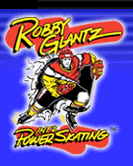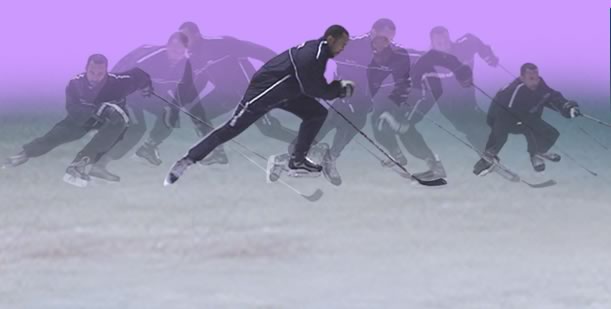Transition Moves
Whenever we watch a great NHL game, it always makes us realize how important Transition Moves are in Hockey (and this holds true for both Ice and In-Line Skates). One common myth is that only defenseman have to be proficient in all transition moves, but you only have to have seen a Joe Sakic or a Teemu Selanne go from backward to forward to score a goal to realize that is a fallacy. The great skating forwards have the ability to transition from backward skating to forward, and are able to do so while still getting all their weight centered over their skates in order to drive down and into a slap shot (which they often blast directly off a pass). This is just one excellent example of how a transition move can help you during a game. In this month's article we will discuss the techniques and fundamentals for transition moves.
FORWARD TO BACKWARD
Key Points:
· Bend your knees deeply so that they are covering your toes.
· The back is straight, head is up and eyes are forward.
· Make sure that you turn your hips 90* from the direction that you were originally traveling, with both skates turning the same way at the same time.
· Your upper body must remain centered directly over your skates, if you lean too far in either direction, this will throw off your balance.
· The outside skate is planted firmly on an Inside Edge and pushes a "half-moon shape" going up and out and cutting deeply into the ice.
· The inside skate trails the outside one and is on an Outside Edge. This is the leg that will get you going in a straight line backward, as it pulls underneath the body extremely hard and to full extension, forming a big letter "Y".
· Continue to pull the Crossunder leg to accelerate and also to straighten out your line of travel.
Skating Imagery:
Picture the fact that when you are facing one direction, that you obviously have to make a 360° turn to get all the way around to that original position. With that in mind your first and only pivot should be ° of that (90°). It is vital that you make your turns as direct as possible. Too many players, professionals included, first turn their skates 90° in the wrong direction and then have to swing the hips a full 180* just to get going in the correct direction. This is a totally wasted movement which will decrease the directness, balance and speed of your turns.
BACKWARD TO FORWARD
Key Points:
· Bend your knees deeply so that they are covering your toes.
· The back is straight, head is up, eyes and chin are forward.
· Make sure to center all of your body weight over the pushing or turning skate. This skate will turn automatically if it is planted firmly on an inside edge.
· Return the other skate (the foot you will land on) directly under the body, slightly off the ice, forming the "Arrow Tip (*)" position.
· The pivoting foot is your pushing skate. Counterbalance against it to maintain the grip to get power and speed from the first push.
· Once you find your balance point and begin to get your momentum going in the other direction, pop up on the toes of your skates to get that quick start forward.
Skating Imagery:
Try to picture this maneuver as a °-turn. This is because if you let your hips turn too far, for example ° ot the way around, this will really slow you down and you will not be able to make a quick start forward. Plus, you are not facing the play anymore. Likewise, I see many players who make the mistake of jumping off of the inside edge (the pushing/turning foot) too soon, before it pulls your hips around. Making this error will cause you to lose all your momentum because you will have to put the other skate on the ice and you still are not facing in the direction that you need to go.





